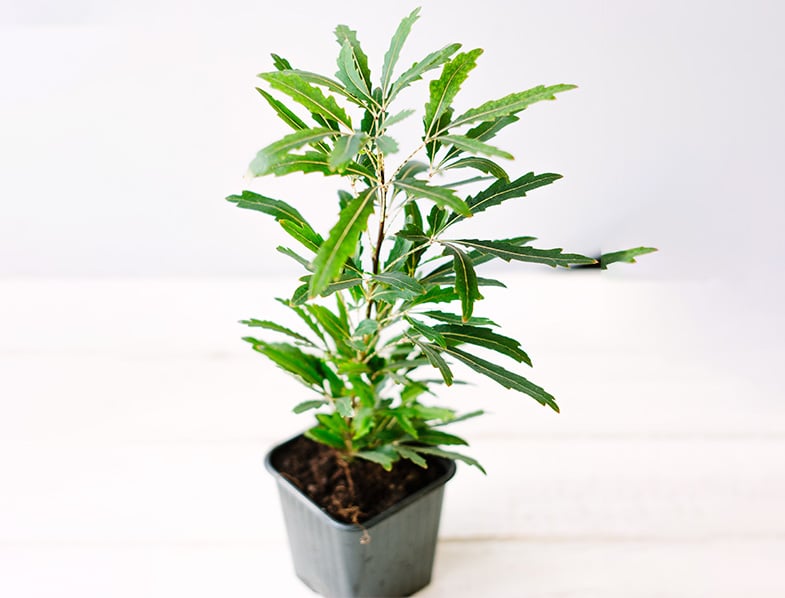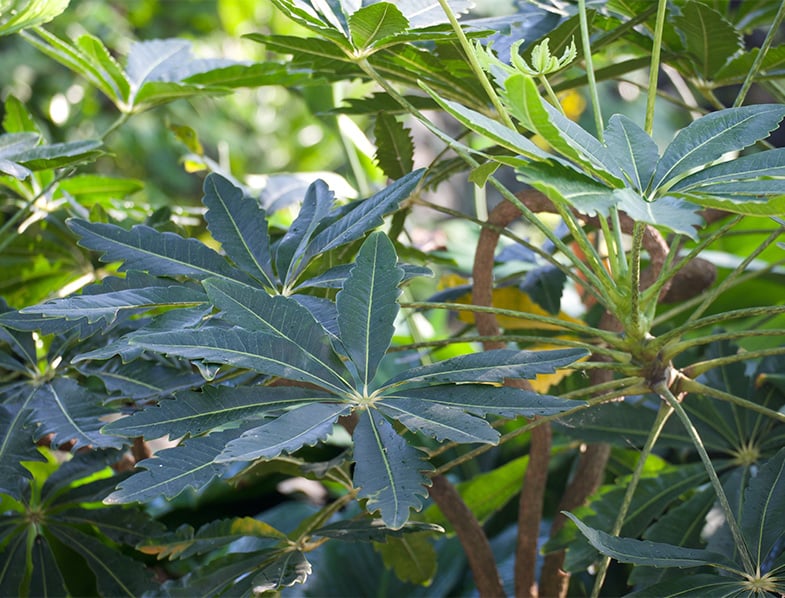The False Aralia is an attractive plant that is suitable for indoor planting. Its leaves have elegant serrated edges that look almost like lace which will make it a unique addition to any indoor garden.
If you love tropical houseplants, the Schefflera Elegantissima is a creative choice that will add an eye-catching touch to your home or offices. They do require a bit more care and attention than other plants.
It is important that once you choose their setting that you avoid moving it unless absolutely necessary. Sometimes, it will start to wilt or even shed its leaves if moved too often. It is not prone to pests other than spider mites, which can be prevented by regular misting.
The spider aralia is mainly chosen for the look of its leaves, and it’s easy to grow nature. The plant starts off with cute looking coppery leaves that have saw-tooth edges. When the plant reaches full maturity, their true beauty can be seen.
The leaves on a mature spider aralia are so rich and deep that they appear almost black. When exposed to bright light, the color becomes even darker. Most property owners house the spider aralia in pots that are placed on tables or windows, but they can grow much larger with the right care.
Naming change: The false aralia was recently reclassified from the Dizygotheca genus and renamed Schefflera elegantissima, which now makes it a relative of the Schefflera plants.
Watch Our Latest YouTube Video ...
About The False Aralia
- The botanical name of the False Aralia is Schefflera Elegantissima.
- The plant has leaves the resemble fingers due to the circle step tops.
- Young False Aralia plants have brown coppery colored foliage.
- The False Aralia is also called the Spider Aralia and the Finger Aralia.
- Schefflera Elegantissima are generally long-lived plants.
- The False Aralia is a Pacific Island native plant.
- Schefflera Elegantissima usually grow as tall as six feet when raised indoors.
- Low temperatures will cause the leaves to wilt and fall off of this plant.

The False Aralia Features: An Overview
- A common name for the False Aralia is the Finger Aralia
- The slender leaves of this houseplant grow in a circle giving them a unique appearance.
- As the False Aralia gets older, the leaves turn a green, almost black color.
- The False Aralia grows very slowly which makes it a good choice for those looking for low maintenance plants.
- The trunk of the False Aralia looks like a tree trunk which will appear as it matures.
- It is important to keep the roots of the False Aralia tightly contained for proper growth.
- The plant will grow tall, so potting it in a heavy but small container will keep it from falling over.
- The False Aralia comes from the South Pacific originally.
- In the wild, Schefflera Elegantissima can be found as tall as 20 feet.
- These plants require at least 50% relative humidity in order to survive.

Growing The False Aralia
Growing the false aralia is not hard, but it does require general attention to detail. They mature well outdoors but are unable to transfer between outdoor and indoor climates. If you want to plant the false aralia outdoors, make sure to use two separate cuttings as opposed to moving your plant seasonally.
The ideal temperature for the plant when cultivated for indoor use is between 65 degrees and 85 degrees. Although it is a generally stable plant, it will begin to wilt and drop leaves if the temperature goes below 60 degrees.
Finger Aralia plants need to be fertilized twice a month during the spring and summer growing season. In the cooler months, it will need to be fertilized once every three to four weeks. Any high-quality liquid houseplant fertilizer will suffice to feed the plant.
The Finger Aralia prefers to live in pots that compress the roots, so you will not need to repot every season like other houseplants. Refreshing the potting soil in the same pot each spring will help trigger growth and help the plain maintain steady health.
The plant does become top-heavy as it matures, so make sure to house the plant in a heavy bowl-shaped pot that is thick at the bottom.
- Exquisite Variegation: Elevate your indoor or outdoor space with the captivating beauty of Fatsia Spider Web. Admire its large, palmate green leaves adorned with intricate white variegation, a living masterpiece that evolves with each passing season.
- Versatile All-Season Charm: Unveil the evergreen allure that spans the entire year. Witness the transformation of markings with age and seasons, making the Fatsia Spider Web a captivating spectacle. It effortlessly adapts to changing environments, seamlessly transitioning between indoor and outdoor settings.
- Graceful Bloom and Berry: Delight in the fall blooms as round clusters of petite white flowers emerge, followed by the emergence of small black berries. A testament to its hardiness and adaptability, adding a touch of elegance to your garden or indoor plant collection.
- Low-Maintenance Elegance: Embrace the ease of caring for the Fatsia Spider Web. Thriving in partial shade, ensure a nutrient-dense, well-draining soil mix, consistent moisture, and moderate temperatures. Disease-resistant and resilient, it effortlessly adds a touch of sophistication to your space.
- Propagation Mastery: Become a plant enthusiast with easy propagation methods. Whether through stem cuttings, air layering, or seeds, nurture new growth and expand your botanical haven. Unleash your green thumb and witness the Fatsia Spider Web thrive under your care.
- A great houseplant
- Exotic plant
- Registered CA. State Nursery
- LIVE HOUSEPLANTS: A growers choice 6-pack plant collection featuring these easy plants: a live Fittonia plant, a live Pothos plant, a Dieffenbachia plant, an Aralia plant, and other green plants.
- NATURAL HOME DECOR: Use your plants for living room decor or even home office decor. A foliage plant like a Pothos live plant or Fittonia live plant are the easiest, low-maintenance live plant decor.
- GIFTS FOR PLANT LOVERS: Surprise someone special with these plant gifts along with other live plants like a snake plant, Hawaiian pothos live plant, tradescantia, and plant accessories like plant terrariums, houseplant soil and plant pots.
- MORE INDOOR HOUSE PLANTS: Your mix may include a chlorophytum comosum spider plant, heart leaf philodendron live plant, scindapsus live plant, ficus repens, peperomia live plant, and more.
- HOUSEPLANT DELIVERY: Your grower’s choice plant pack includes 6 healthy plants, delivered right to your doorstep. Each plant ships in a 2” container. The plants in each pack will vary in height, approximately 4" tall.
Last update on 2024-10-07 / Affiliate links / Images from Amazon Product Advertising API
Watering The False Aralia
Watering false aralia plants is similar to most houseplants. This is a shade loving plant and won’t require as much moisture as those who need more sun. The soil should maintain a rich quality but be allowed to dry to within 2.5 cm of the surface before being watered again. Insert a finger into the soil up to about the second knuckle. If the soil is dry, drench the plant and allow the water to completely filter through the pot.
Make sure there are ample drainage holes in a bottom-heavy pot. The heavy pot will prevent tipping, and the drainage holes will help to ward off root rot. After each watering, allow the water to drain into the collection tray and then empty the tray once the water has completed draining.
Fertilize the plant every other week during your regular watering session during the growing season. This should be done only once monthly during the dormant winter months.

Propagating The False Aralia
Propagating the False Aralia is easy and can be done from cuttings off the stem tips. Springtime is the prime growing season for the plant and also the best time to both prune and propagate the plant.
Cut a generous tip from the stem of a mature plant in the spring and then liberally dose the end in a rooting powder hormone. This cutting should then be placed in a fresh pot of rich soil that has been fed with a water-soluble fertilizer.
Cover the cutting and the pot in a plastic bag to help maintain a healthy and balanced level of humidity around the new plant.
You can also propagate the False Aralia from seedlings. It is best to house them in a terrarium and also under steady fluorescent light. The plant and seedlings need bright light to grow, however, they will wilt and burn if exposed to direct sunlight.

Being that this is a tropical plant, you will need to cover the seedling with a plastic bag and mist often until it matures. Maintaining a temperature that ranges between 65 degrees and 85 degrees is ideal for Schefflera Elegantissima.
Moving the plant is not recommended. When you propagate the plant in the spring, choose a spot or at least a room where the plant will spend the majority of its life. It is very sensitive to climate and location changes, even as a seedling.
The spring is the best time to move this plant if you must move it at all. Watch out for spider mites in new plants and mature plants alike. Spider mites have the potential to trigger plant death.
The best way to care for an infested plant is to wile the bottoms of the leaves with gentle insecticidal soap. You can also mist the plant twice daily to help banish lingering mites.
In Conclusion
Natively found in New Caledonia, the Schefflera Elegantissima is best suited to US zones 10 and 11. The False Aralia can be cultivated both indoors and outdoors, but those that are raised outdoors have a hard time transitioning to indoor settings.
If you live in a warm climate that gets plenty of sunlight, the False Aralia will thrive in your home. The False Aralia should be placed outside of direct sunlight when grown outside or when raised indoors to prevent leaf burn. It will thrive in normal indoor temperatures and doesn’t need complicated humidity levels. All of this makes it a great choice for small homes, condos, or even larger homes with plenty of space and natural lighting.
The Schefflera Elegantissima can get rather top-heavy, it is a good idea to place it in a decorative pot with a gavel on the bottom to keep it from falling over. The plant is finicky in that it doesn’t like to be moved, in fact, it can cause the leaves to fall off.
Choose an ideal location that you won’t mind dedicating your plant, and if you do decide to move it, only do so in the spring. It is generally resistant to pests, but like all houseplants, it is important to check for mealybugs. They can fall victim to spider mites, and a serious infestation will result in plant death.
The False Aralia are generally easy to grow indoors and do not need a specific level of humidity to grow. They prefer less moisture, but overly dry plants will start to shed leaves. Outdoor False Aralia plants should be planted in a shaded area and monitored for leaf drop and mite infestations.
When purchasing your first False Aralia, keep in mind that new plants have copper leaves while mature plants have deep-colored lobed leaves.



